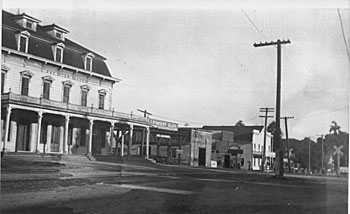The First Residential Development in Aptos
By Kevin Newhouse

The first private owner of land in Aptos was Rafael Castro. In 1833, Castro was deeded 5,500 acres as part of a Mexican land grant. Between 1833 and 1850, Aptos remained undeveloped ranch land where Castro’s cattle could roam free. Around 1850, Castro began to lease his land to the “Yankees,” at which time a wharf, a general store, and a logging mill were built.
Around 1872, Claus Spreckels, the millionaire “sugar king” had bargained with Castro to purchase roughly 2,300 acres of land; most of the remaining land that Castro had not already gifted to his children or sold to others. Thus, the Castro-Era of Aptos ended as well as the time of Indian-Spanish-Mexican dominance.
During the Spreckels-era, railroad lines were installed and the main industry in Aptos had shifted from ranching and cattle hides to lumber. Spreckels built a luxurious first class hotel that you could have argued was the nicest hotel in California at the time. It was located in Rio Del Mar at the intersection of Claus Court and Spreckels Drive, which explains the origin of these street names! He had hoped to attract tourists and spark growth. Aptos, however, was a rough and rugged logging town and Spreckels’ dream of growth was short-lived. His hotel closed and the building was torn down in 1896-1897.
Claus Spreckels passed away in 1908 and his land was passed to a trust called The San Christina Investment Company. The Trust decided to sell the property in 1922 to Fred L. Somers who was a real estate investor from Pomona, CA. The 2,390 acres were sold for $220,000. By this time, the timber industry had come to an end and the focus had shifted to apples.
The Santa Cruz News reported on May 29, 1924 that Mr. Gingg of San Jose had purchased the land on Trout Gulch Road to build a summer home on part of the property. The remainder of the land would be subdivided for cottages. The development, initially known as Forest Park, changed its name to Forest Glen with no explanation as to why the change was made. On June 15, 1924, the first day that the 112 lots on the tract were made available for purchase, nine lots were reported sold. One writer boasted that never again could Aptos be called a “sleepy village” which is what a San Francisco reporter had written some years before. Another article said Aptos was now “on the map” and intended to remain there.
The entrance to Forest Glen was off Trout Gulch as seen in the picture with the Bay View Hotel on the left and the old Blacksmith Shop on the right. Trout Gulch and Valencia Roads bordered the timbered bungalow and cabin sites on either side with a mountain stream running through the property mostly parallel to the roadways. There was even a bridge over the creek that connected Trout Gulch with Valencia Road.
Today, most of the cabins have been modified and modernized. The bridge over the creek is long gone and so is the entrance sign over Trout Gulch Road. The Forrest Glen development was the first of its kind in Aptos and it no doubt sparked subsequent projects. Forest Glen was a major player in the development of Aptos but it remains today as only as a very distant memory.